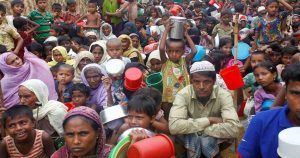In the wake of the collapse of eight-storey factory Rana Plaza in Savar, Human Rights Watch, a New York-based rights group, has observed that the tragic incident shows the urgent need to improve Bangladesh’s protections for worker health and safety.“Reforms should include a drastic overhaul of the government’s system of labor inspections and an end to government efforts to thwart the right of workers to unionise,” the rights body said in a statement on Thursday.
The building was evacuated the previous day when large cracks had appeared in its walls. Numerous workers in the building were reluctant to enter the premises on the morning before the collapse, but did so after being told the building was safe or after alleged threats from company officials, it said.
“Given the long record of worker deaths in factories, this tragedy was sadly predictable,” said Brad Adams, Asia director at Human Rights Watch.
“The government, local factory owners, and the international garment industry pay workers among the world’s lowest wages, but didn’t have the decency to ensure safe conditions for the people who put clothes on the backs of people all over the world.”
The Rana Plaza collapse is the latest in a long list of factory building tragedies in Bangladesh, Human Rights Watch said. In April 2005, 73 garment workers died in a factory collapse in Savar. In February 2006, 18 workers were killed in a garment factory collapse in Dhaka. In June 2010, 25 people were killed in a building collapse in Dhaka. In November 2012, more than 100 workers died in a fire at a factory in Dhaka.
Mentioning that Bangladesh has notoriously poor workplace safety inspection mechanisms, the global rights watchdog said. “The Ministry of Labour’s Inspection Department, responsible for monitoring employers’ adherence to Bangladesh’s Labour Act, is chronically under-resourced. In June 2012, the Inspection Department had just 18 inspectors and assistant inspectors to monitor an estimated 100,000 factories in Dhaka district, where the Rana building is located. The garment sector alone employs an estimated 3
million workers.
“Successive Bangladeshi governments have paid lip services to worker safety but in reality it is only the factory owners who have the ear of policymakers,” Adams said.
Labor groups in Bangladesh operate in a pervasively hostile environment, the rights body said adding that the April 2012 torture and murder of labor rights activist Aminul Islam, who had earlier been arbitrarily detained and tortured by government security forces remains unsolved.
Over a dozen labor rights leaders currently face criminal charges on a variety of spurious grounds. The government has continued to pursue legal action aimed at intimidating the Bangladesh Center for Worker Solidarity (BCWS), a nongovernmental organisation (NGO) that works closely with trade unions, and has arbitrarily revoked its NGO accreditation.
Many factory owners in Bangladesh are parliamentarians or members of the main political parties. In an interview with a government minister in 2011, the minister told Human Rights Watch that it would be “impossible” to improve workers rights so long as factory owners were senior members of political parties.
“How many factory tragedies will it take before the Bangladeshi government ends its cozy relationship with powerful company owners and prioritizes worker safety?” Adams asked. “Until Bangladesh regulates workplaces properly and gets serious about unsafe working conditions and those who create them, those on the factory floor will continue paying with their lives.”UNB




